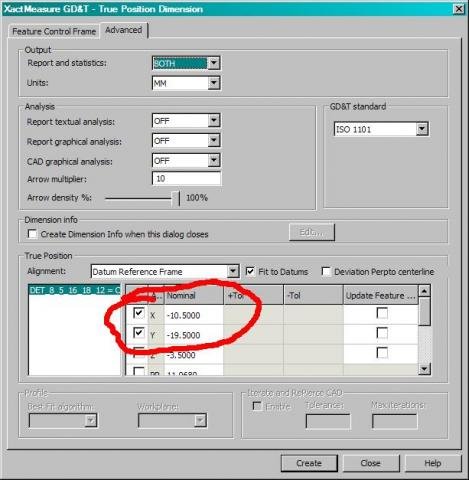Your Products have been synced, click here to refresh
Your Products have been synced, click here to refresh
I try not to alter alignments when reporting. The problem seems to happen if I report TP of several features in the same report. If I go back and adjust the nominals or change from Datum Reference to Current Alignment, frequently anything reported after that will suddenly not report nominals. If I recreate all the reporting features that are giving me a problem, I sometimes can get my nominals to show on the report again. It seems trial and error mostly to get a report displaying properly again. Getting the report (and proof reading the final product) can take up 1/2 the time I spend writing a program.
I have been using Datum Reference Frames mostly. I had no idea about Xactmeasure making the first datum in the Z direction. Most of our parts are laid out so that the first datum does align with the Z adn frequently the second is aligned with the X. I'll have to go back and look at instances where this is not the case.
Other than the reporting item I posted above, we're pretty happy with 4.2. It was a big jump from 3.2. Most of the problems we had turned out to be programmer error. But this one has been elusive to fix by training and practice. That's why I'm curious if the items you noted in class hold true for 4.2. Our SMA is expired a while ago, but we haven't need more advanced features. If going to 2009 or 2010 solves this issue and adheres to standards, I have a much better shot of getting the SMA renewed.

I try not to alter alignments when reporting. The problem seems to happen if I report TP of several features in the same report. If I go back and adjust the nominals or change from Datum Reference to Current Alignment, frequently anything reported after that will suddenly not report nominals. If I recreate all the reporting features that are giving me a problem, I sometimes can get my nominals to show on the report again. It seems trial and error mostly to get a report displaying properly again. Getting the report (and proof reading the final product) can take up 1/2 the time I spend writing a program.
I have been using Datum Reference Frames mostly. I had no idea about Xactmeasure making the first datum in the Z direction. Most of our parts are laid out so that the first datum does align with the Z adn frequently the second is aligned with the X. I'll have to go back and look at instances where this is not the case.
Other than the reporting item I posted above, we're pretty happy with 4.2. It was a big jump from 3.2. Most of the problems we had turned out to be programmer error. But this one has been elusive to fix by training and practice. That's why I'm curious if the items you noted in class hold true for 4.2. Our SMA is expired a while ago, but we haven't need more advanced features. If going to 2009 or 2010 solves this issue and adheres to standards, I have a much better shot of getting the SMA renewed.

| © 2025 Hexagon AB and/or its subsidiaries. | Privacy Policy | Cloud Services Agreement |